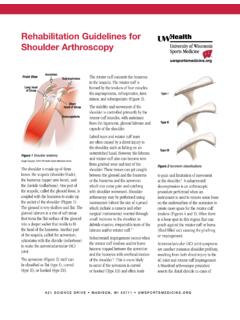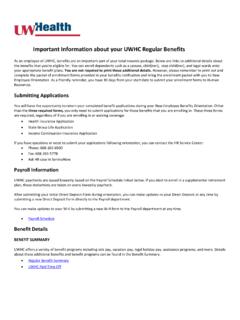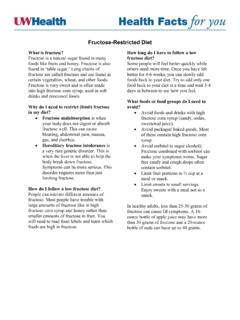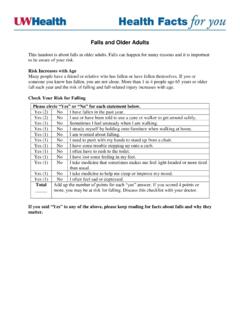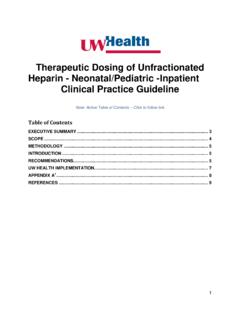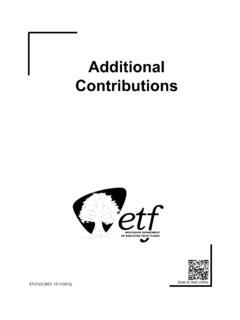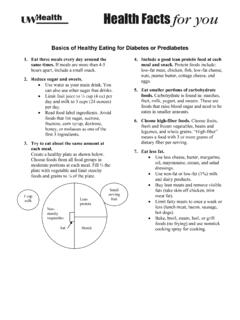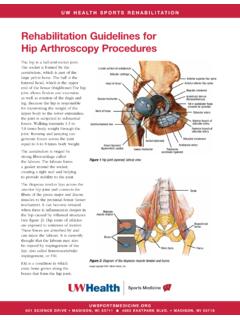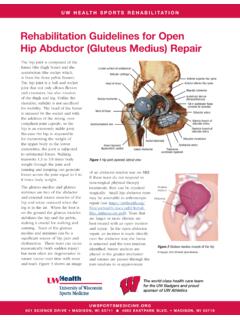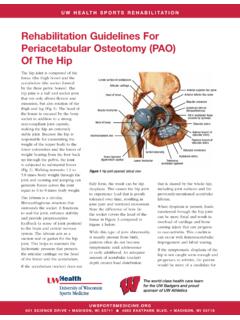Transcription of Rehabilitation Guidelines for Achilles Tendon Repair
1 UW HEALTH SPORTS REHABILITATIONThe world class health care team for the UW Badgers and proud sponsor of UW 621 SCIENCE DRIVE MADISON, WI 53711 4602 EASTPARK BLVD. MADISON, WI 53718 Rehabilitation Guidelines for Achilles Tendon Repair The Achilles Tendon is the strongest and thickest Tendon in the body. It attaches the calf muscles (soleus and gastrocnemius) to the heel bone (calcaneus). The Tendon transmits force from the contracting calf muscles to the calcaneus to cause the foot action of plantar flexion (foot pointed down) that is important in walking, running, jumping and change of direction activities.
2 Although the Achilles Tendon is the strongest Tendon in the body, it is also the Tendon most commonly torn or ruptured. The most common causes of rupture are: Sudden plantar flexion (foot moving downward) such as taking off to jump. Unplanned or forced dorsiflexion (foot moving upward) such as landing a jump or stepping into a hole. Direct trauma to the Tendon . Most Achilles Tendon ruptures occur in sports that require running, jumping and change of direction. The typical age for rupture occurs between 30 40 years of age and is significantly more common in males than females.
3 Older adults can also rupture the Achilles Tendon and are more inclined to have degenerative partial tearing of the Tendon . Other risk factors for Achilles Tendon rupture include use of Fluoroquinolone antibiotics and direct steroid injections into the Tendon . The diagnosis of an Achilles Tendon rupture is made from clinical history, physical exam and diagnostic testing. Most patients who sustain an Achilles Tendon rupture report a pop and a feeling of being kicked or shot in the back of the leg. On exam, there is a palpable divot or gap in the area of the rupture along with significant swelling.
4 Patients will demonstrate a positive Thompson test, performed by squeezing the calf muscle while the patient lies prone. This test is positive when the calf is squeezed and plantarflexion does not occur. Diagnostic testing such as an Ultrasound or MRI (magnetic resonance imaging) may be used to determine if there is a complete or partial tear. Treatment options for an Achilles Tendon rupture include surgical Repair and conservative non-surgical Rehabilitation . Decision making is based on age, past medical history and desired level of functional return.
5 Conservative non-surgical treatment includes Rehabilitation with initial immobilization followed by gentle range of motion and progressive strengthening to regain function. Most surgical procedures to Repair a torn Achilles Tendon include an open longitudinal incision medial to the Achilles Tendon (Figure 1). The incision is made medial to the Tendon to improve skin healing and to reduce the risk of scarring to the underlying Tendon Repair . Once the incision is made and the rupture is identified (Figure 2), clamps are used to match the ends together in an optimal Tendon length.
6 A primary Repair of the two ends of the Tendon is performed by stitching them together. There are many different stitching techniques to Repair the Tendon . The type used will depend on the surgeon, the type of rupture, and tissue the Repair is augmented or strengthened using fascia or Tendon . A gastrocnemius aponeurosis augmentation is performed when a 1 2 cm wide by 8 cm long flap is made and turned down over the Repair and sutured to reinforce the Repair . The area that the flap was harvested from is then stitched together.
7 In cases of Tendon degeneration, or tendiosis, this may help strengthen the repaired it has been thought that a surgically repaired Achilles Tendon offered a significantly smaller risk of Figure 1 The dotted line represents the longitudinal incision used to expose the ruptured Achilles Tendon during surgical 2 Torn Achilles Guidelines for Achilles Tendon Repair 621 SCIENCE DRIVE MADISON, WI 53711 4602 EASTPARK BLVD. MADISON, WI 53718re-rupture rate and increased strength in comparison to non- surgical treatment.
8 The major risks associated with surgery include infection, deep vein thrombosis (DVT) and difficulty with wound closure. Recent studies suggest similar rupture rates, strength and mobility between surgery and non-surgery approaches to the management of Achilles Tendon ruptures. The best approach varies for each individual. Your surgeon and you will determine what is best for you by discussing your specific injury and goals. Rehabilitation following Achilles Tendon Repair is vital in regaining motion, strength and function.
9 Initially a walking boot is used for the first 4 5 weeks. Gradually more weight bearing and mobility is allowed to prevent stiffness post-operatively. The Rehabilitation progresses slowly into strengthening, gait and balancing activities. Rehabilitation Guidelines are presented in a criterion based progression. General time frames refer to the usual pace of Rehabilitation . Individual patients will progress at different rates depending on their age, associated injuries, pre-injury health status, rehab compliance, tissue quality and injury severity.
10 Specific time frames, restrictions and precautions may also be given to enhance wound healing and to protect the surgical I (surgery to 2 weeks after surgery) Appointments Rehabilitation appointments begin 14-16 days after surgeryRehabilitation Goals Protection of the surgically repaired Tendon Wound healingPrecautions Continuous use of the boot in locked plantarflexion (20-30 ) Touchdown weight bearing (TDWB) using the axillary crutches Keep the incision dry Watch for signs of infection Avoid long periods of dependent positioning of the foot during the first week to assist in wound healingCardiovascular exercise Upper Body Ergometer (UBE) circuit trainingProgression Criteria Two weeks after surgeryPHASE II (begin after meeting Phase 1 criteria, usually 2 -4 weeks after surgery)
